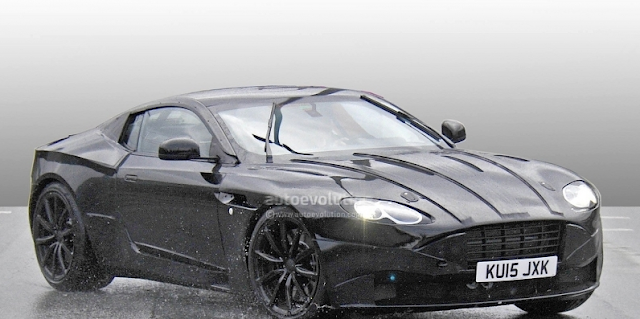The 2017 Aston Martin DB9 Automatic | We begin with the awful news: As beforehand reported, Aston Martin's great sounding normally suctioned V-12 motor won't make the move to the new DB11. The motor that has controlled the greater part of the organization's bigger items since 2003, and was basically two Ford Duratec V-6s joined at the wrench, is forthcoming resigned and we won't hear its brilliant howl once more. Dark armbands will be issued.
How about we brighten ourselves up by skipping straight to the better news, to be specific that the DB11 has opposed the pattern of diminished barrel check and is keeping a V-12, for this situation another twin-turbocharged unit that Aston has created itself. (We'll need to sit tight until the substitution for the littler Vantage to meet the main AMG-fueled Aston.) The new 5.2-liter V-12 offers bore focuses with the old 5.9-liter motor and will be worked at Aston's motor plant in Cologne, however everything else about it is guaranteed to be new. We think that the motor's 600 torque—60 more thanthe DB9 GT—will help most potential purchasers proceed onward rapidly from the torment of losing the old normally suctioned motor. It additionally creates 516 lb-ft of torque, accessible from 1500 rpm to 5000 rpm. By difference, the DB9's maximum of 457 lb-ft landed at a grand 5500 rpm.
 |
Model 2017 Aston Martin DB9 EngineModel 2017 Aston Martin DB9 Engine | 800 X 531
|
Aston's designing manager Ian Minards guarantees us that the DB11's motor has been created to convey slack free reaction with one turbocharger and intercooler per bank. This encourages barrel deactivation, with the motor closing down an entire bank under tender use to wind up a 2.6-liter inline-six (it then will intermittently change between banks to keep the impetuses hot and even out motor wear). The transmission is the same eight-speed ZF programmed as fitted to the Vanquish, yet with force sent to the back wheels through a torque-vectoring differential.
Turbos in any case, the DB11 is generally reassuringly unsurprising. Aston is quick to underline how diverse it is from the matured DB9, and in reality it utilizes another aluminum design that will support all the brand's future models. In any case, any reasonable person would agree it adheres to the Aston GT formula as nearly and mindfully as a fledgling culinary specialist. The structure is still framed from fortified aluminum, the body boards are likewise aluminum, and the outline pays veneration to its attractive ancestors while never getting to be deferential. The most clear visual contrast is the "rooftop strake" that keeps running from the base of the A-column, over the glass, and to the base of the C-column, and which is accessible in aluminum, dark, or body shading.
Measurements are fundamentally the same as the DB9. The DB11 is 1.2 creeps longer, 2.7 inches more extensive, 0.3 inch higher, and sits on a wheelbase 2.5 crawls longer. Weight is almost indistinguishable, the manufacturing plant dry-weight figure of 3902 pounds being only 33 pounds lower, yet Aston says that the new motor is significantly heavier and in this way the body shell's mass diminishment is somewhat masked. The DB11 is far superior bundled than its antecedent, however, with more inside space and nearly usable back seats rather than what was, in the DB9, minimal more than gear space with safety belts.
Underneath the surface there is more advancement. The DB11 gets another multilink back suspension and electrically helped power guiding, a first for Aston, and additionally a cunning new streamlined features framework. It coordinates air around the auto without the requirement for any pompous wings or endless diffusers. The key component is the thing that the organization calls the AeroBlade, which utilizes ducting to take wind stream from the base of the C-column to the trailing edge of the storage compartment, where it is coordinated upward at 90 degrees, obviously conveying a large portion of the advantages of a wing without expecting to muss up those lovely lines. It works at rates of up to around 90 mph, above which a little spoiler ascends to help it.
The most observable changes are those that have been created in the lodge, with the entry of Daimler's electronic design, the other part of the two organizations' coordinated effort. This isn't especially very much masked, with a revolving controller and touch-delicate board indistinguishable to the one found in Mercs. The DB11 likewise has a solitary control stalk for both its wipers and turn signals, taken straight from the Benz parts container. The lodge is impeccably completed and profits by TFT instruments and a 8.0-inch show screen in the focal point of the dashboard. Alternatives incorporate a fueled armrest, programmed stopping, and a 1000-watt Bang and Olufsen sound framework, despite the fact that the DB11 doesn't get a large number of the Mercedes dynamic wellbeing frameworks that we were hoping to show up, as the auto is not fitted with long-go radar sensors. The absence of versatile voyage appears to be especially odd in a present day auto that has been planned around a terrific visiting brief.
The DB11 will be evaluated at $214,820 in the U.S., with first conveyances beginning in the final quarter. It's anything but difficult to portray as metaphor Aston's request that the DB11 is the most critical dispatch in its 103-year history, yet it reflects reality this is the model that will exhibit whether, following quite a while of stagnant deals, the organization has a feasible future. For that, we wish it well.
Sign up here with your email

ConversionConversion EmoticonEmoticon